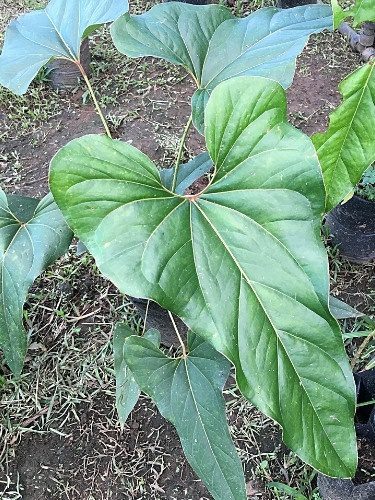Anthurium brownii is a herbaceous plant, both epiphytic and terrestrial, with a perennial life cycle, boasting ornamental foliage resembling a heart shape. It is native to Central and South America, found in the tropical forests of Colombia, Costa Rica, Ecuador, Panama, and Venezuela. This plant features a strong, short stem with thick, aerial adventitious roots covered in velamen. Its leaves are supported by long, upright, canaliculated petioles with a prominent brown cushion-like pulvinus at their distal ends. While the leaves have an elongated heart shape common to many aroids, in this species, they form a sort of chalice, as if the veins are pulling up the rest of the leaf, raising its lobes, giving the plant an intriguing texture. They are green, shiny, leathery, twisted, large, and wide. The veins are prominent, with a reddish to purplish color in the central vein and margins, and a yellowish hue in the secondary veins. The inflorescences are of the spadix type, with a recurved green spathe and a long, purple to brown spadix. After pollination, it develops small, globular to elongated fruit, berry-like, with an intense orange color when ripe.

This species is ideal for cultivation in indoor environments, bringing a touch of tropicality and the characteristic “urban jungle” vibe to living rooms, balconies, and offices. Whether in simple, large pots or indoor gardens, the Anthurium browni is perfect for decoration. Minimalistic pots work best, as its foliage is already a significant attraction. In landscaping, it can be grown on the forks of leafy trees or in shaded flower beds. Additionally, it’s an excellent choice for vertical gardens. Maintenance is straightforward and involves removing dead leaves, cleaning the leaves to get rid of dust buildup, and repotting every two or three years to refresh the substrate, promote growth, and restore vitality.
It should be grown in partial shade or filtered light and prefers light, porous, fibrous, well-draining substrates rich in organic matter. A good mix may consist of equal parts of garden soil and partially decomposed pine bark. Avoid exposing it to direct sunlight during the hottest hours of the day, as this can cause leaf burns. Morning or late afternoon sun is ideal, as is light filtered through a sheer curtain. The Anthurium browni enjoys warm and humid climates, with the ideal temperature for cultivation being between 25 and 32°C (77-89°F), and the ideal relative humidity at approximately 80%. In dry weather, humidity can be supplemented with an electric humidifier or by placing water-filled trays with stones under the pots. Watering should be regular, ensuring that the substrate doesn’t dry out completely between waterings, nor does it become waterlogged, as overwatering can quickly lead to root rot. It does not tolerate dry periods, frost, or intense cold.
Fertilize the Anthurium browni during the spring and summer to promote full plant development. Use soluble fertilizers containing micronutrients, as well as foliar fertilizers, such as the traditional NPK 10-10-10, always following the manufacturer’s recommendations for dilution and application. Additionally, the foliage benefits from organic fertilizers like bokashi or biofertilizer. Propagate through division of clumps, stem cuttings, or preferably, in the spring and summer.


